FIN3IFM S1 2019 Homework 2: Transaction Exposure and Risk Analysis
VerifiedAdded on 2022/11/14
|9
|1487
|393
Homework Assignment
AI Summary
This assignment solution delves into key aspects of international financial management, addressing transaction, economic, and translation exposures with relevant examples. It explores the necessity of hedging in imperfect capital markets and calculates net Euro proceeds from a sale, also analyzing exchange risk hedging. Furthermore, it discusses the liquidity risks during the financial crisis, the causes of the 2007 credit crunch, and the roles of structured investment vehicles (SIVs) and collateralized debt obligations (CDOs) in the global financial distress. The document provides a comprehensive overview of these interconnected topics within the realm of international finance.
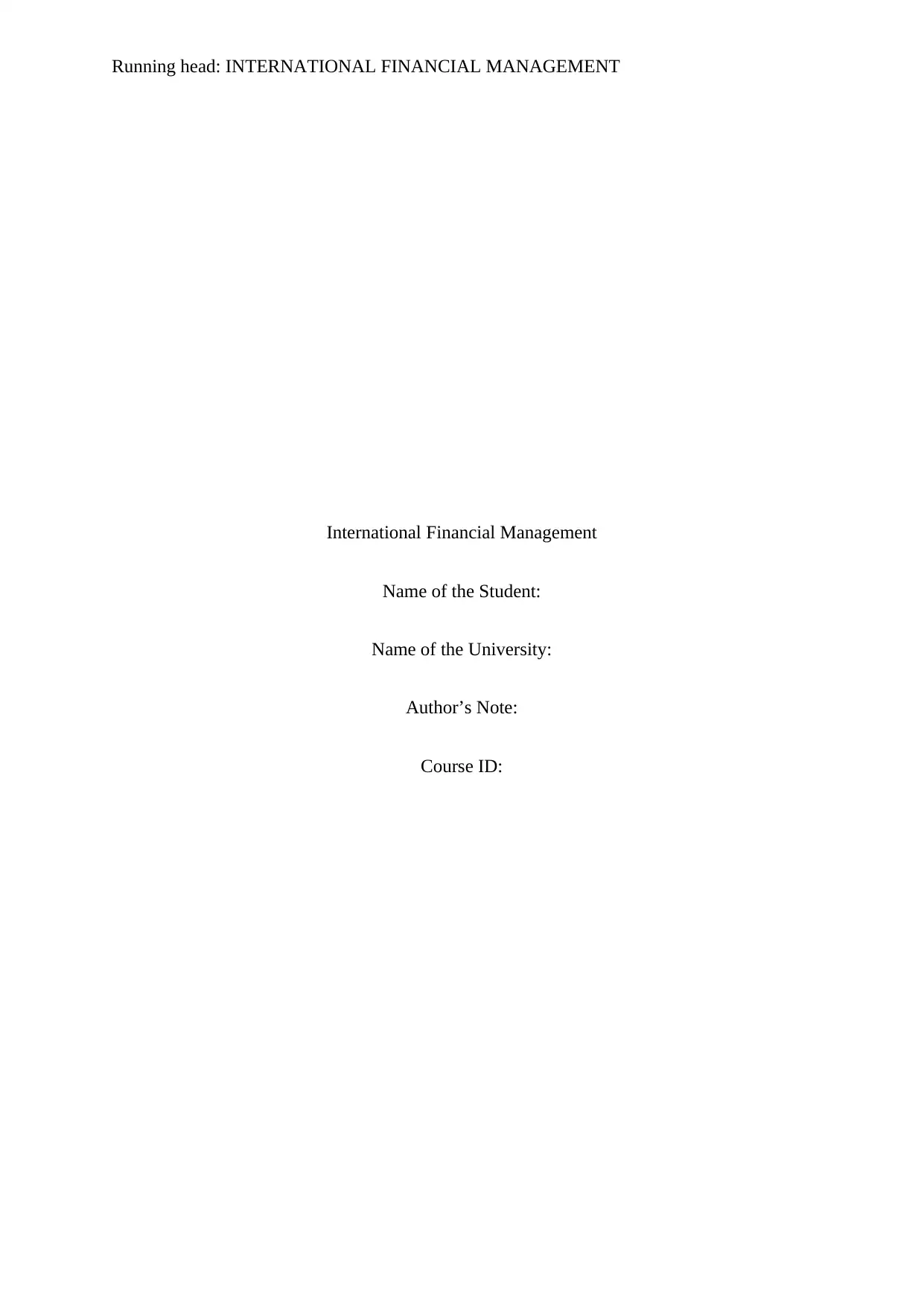
Running head: INTERNATIONAL FINANCIAL MANAGEMENT
International Financial Management
Name of the Student:
Name of the University:
Author’s Note:
Course ID:
International Financial Management
Name of the Student:
Name of the University:
Author’s Note:
Course ID:
Paraphrase This Document
Need a fresh take? Get an instant paraphrase of this document with our AI Paraphraser
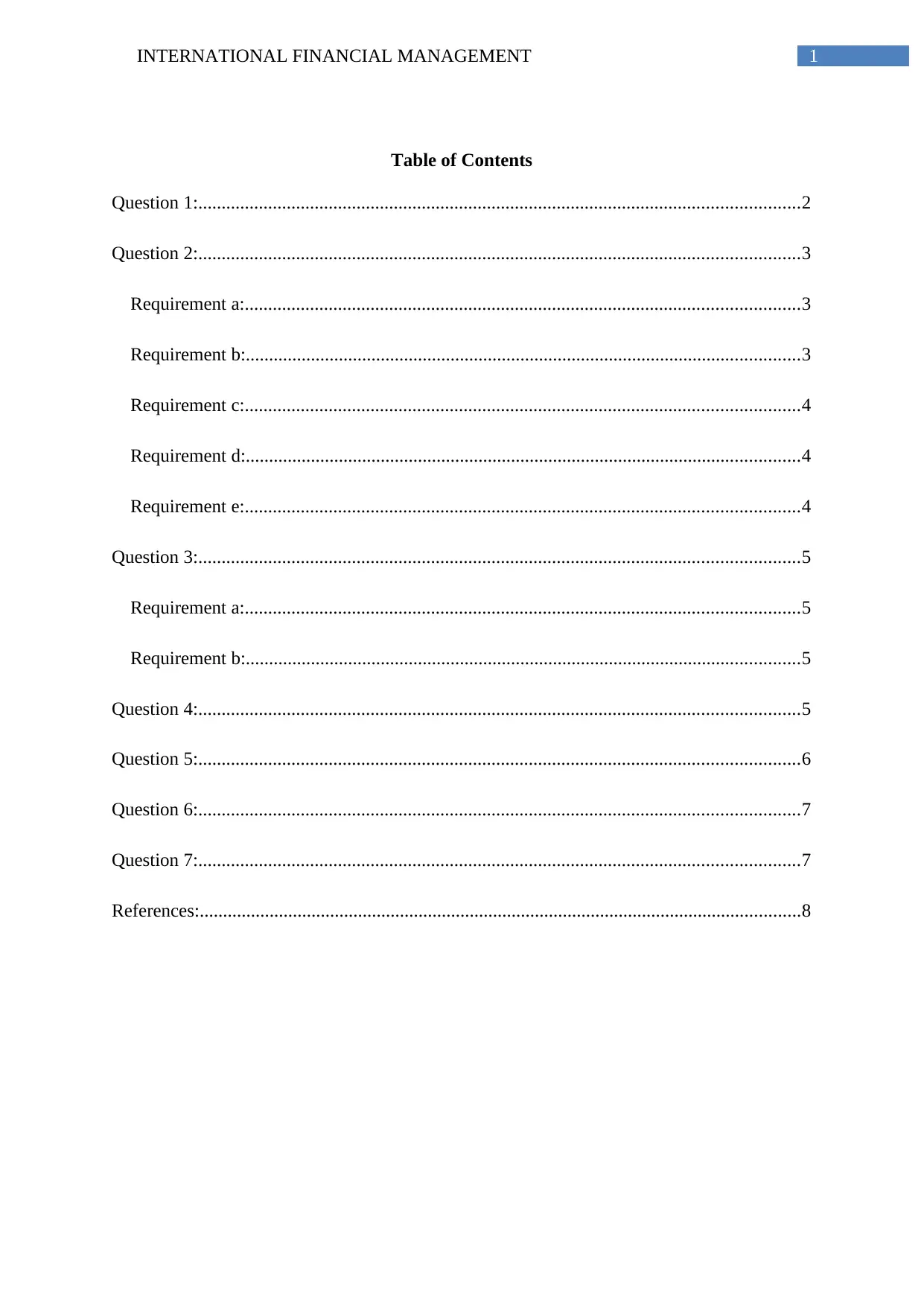
1INTERNATIONAL FINANCIAL MANAGEMENT
Table of Contents
Question 1:.................................................................................................................................2
Question 2:.................................................................................................................................3
Requirement a:.......................................................................................................................3
Requirement b:.......................................................................................................................3
Requirement c:.......................................................................................................................4
Requirement d:.......................................................................................................................4
Requirement e:.......................................................................................................................4
Question 3:.................................................................................................................................5
Requirement a:.......................................................................................................................5
Requirement b:.......................................................................................................................5
Question 4:.................................................................................................................................5
Question 5:.................................................................................................................................6
Question 6:.................................................................................................................................7
Question 7:.................................................................................................................................7
References:.................................................................................................................................8
Table of Contents
Question 1:.................................................................................................................................2
Question 2:.................................................................................................................................3
Requirement a:.......................................................................................................................3
Requirement b:.......................................................................................................................3
Requirement c:.......................................................................................................................4
Requirement d:.......................................................................................................................4
Requirement e:.......................................................................................................................4
Question 3:.................................................................................................................................5
Requirement a:.......................................................................................................................5
Requirement b:.......................................................................................................................5
Question 4:.................................................................................................................................5
Question 5:.................................................................................................................................6
Question 6:.................................................................................................................................7
Question 7:.................................................................................................................................7
References:.................................................................................................................................8
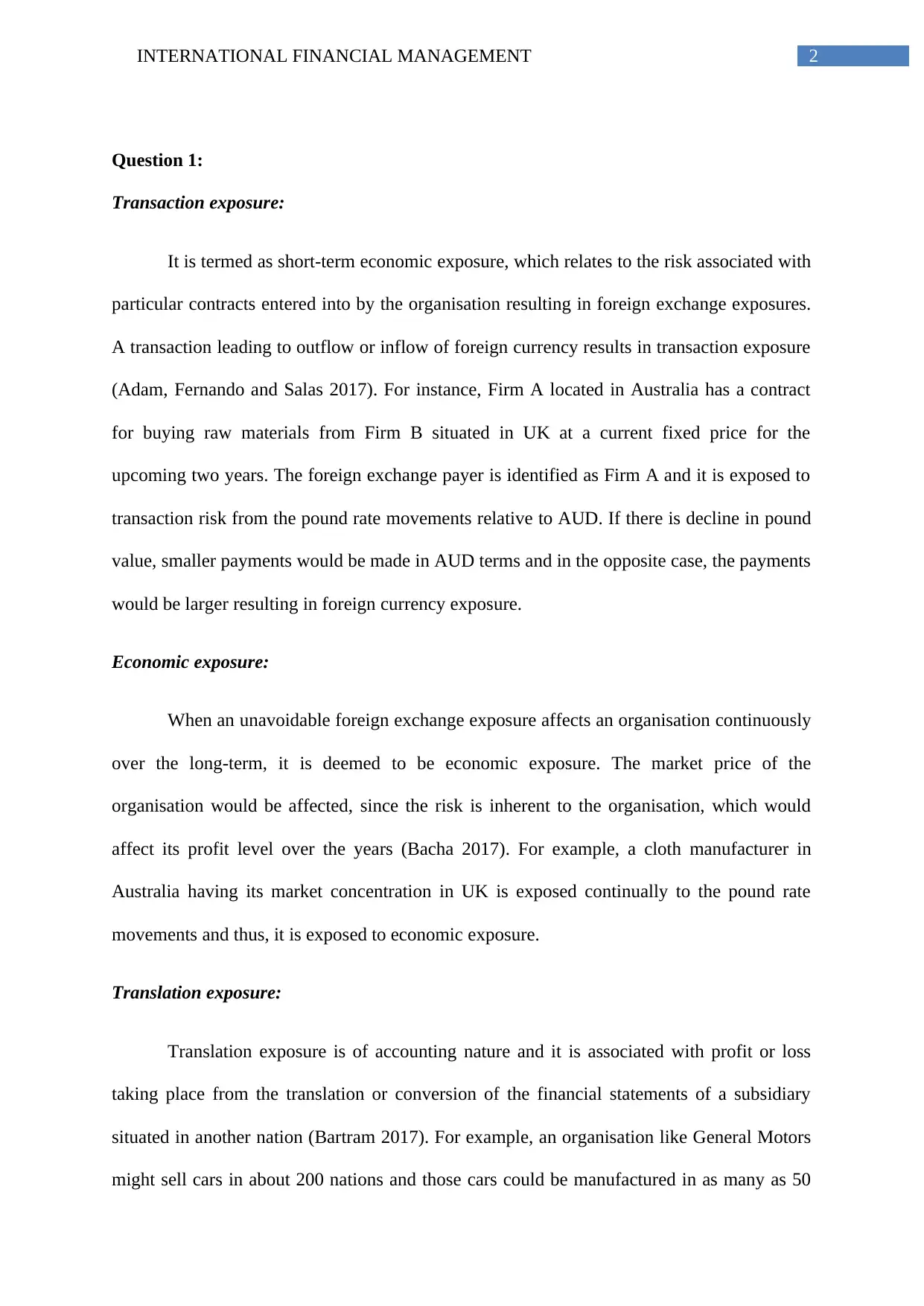
2INTERNATIONAL FINANCIAL MANAGEMENT
Question 1:
Transaction exposure:
It is termed as short-term economic exposure, which relates to the risk associated with
particular contracts entered into by the organisation resulting in foreign exchange exposures.
A transaction leading to outflow or inflow of foreign currency results in transaction exposure
(Adam, Fernando and Salas 2017). For instance, Firm A located in Australia has a contract
for buying raw materials from Firm B situated in UK at a current fixed price for the
upcoming two years. The foreign exchange payer is identified as Firm A and it is exposed to
transaction risk from the pound rate movements relative to AUD. If there is decline in pound
value, smaller payments would be made in AUD terms and in the opposite case, the payments
would be larger resulting in foreign currency exposure.
Economic exposure:
When an unavoidable foreign exchange exposure affects an organisation continuously
over the long-term, it is deemed to be economic exposure. The market price of the
organisation would be affected, since the risk is inherent to the organisation, which would
affect its profit level over the years (Bacha 2017). For example, a cloth manufacturer in
Australia having its market concentration in UK is exposed continually to the pound rate
movements and thus, it is exposed to economic exposure.
Translation exposure:
Translation exposure is of accounting nature and it is associated with profit or loss
taking place from the translation or conversion of the financial statements of a subsidiary
situated in another nation (Bartram 2017). For example, an organisation like General Motors
might sell cars in about 200 nations and those cars could be manufactured in as many as 50
Question 1:
Transaction exposure:
It is termed as short-term economic exposure, which relates to the risk associated with
particular contracts entered into by the organisation resulting in foreign exchange exposures.
A transaction leading to outflow or inflow of foreign currency results in transaction exposure
(Adam, Fernando and Salas 2017). For instance, Firm A located in Australia has a contract
for buying raw materials from Firm B situated in UK at a current fixed price for the
upcoming two years. The foreign exchange payer is identified as Firm A and it is exposed to
transaction risk from the pound rate movements relative to AUD. If there is decline in pound
value, smaller payments would be made in AUD terms and in the opposite case, the payments
would be larger resulting in foreign currency exposure.
Economic exposure:
When an unavoidable foreign exchange exposure affects an organisation continuously
over the long-term, it is deemed to be economic exposure. The market price of the
organisation would be affected, since the risk is inherent to the organisation, which would
affect its profit level over the years (Bacha 2017). For example, a cloth manufacturer in
Australia having its market concentration in UK is exposed continually to the pound rate
movements and thus, it is exposed to economic exposure.
Translation exposure:
Translation exposure is of accounting nature and it is associated with profit or loss
taking place from the translation or conversion of the financial statements of a subsidiary
situated in another nation (Bartram 2017). For example, an organisation like General Motors
might sell cars in about 200 nations and those cars could be manufactured in as many as 50
⊘ This is a preview!⊘
Do you want full access?
Subscribe today to unlock all pages.

Trusted by 1+ million students worldwide
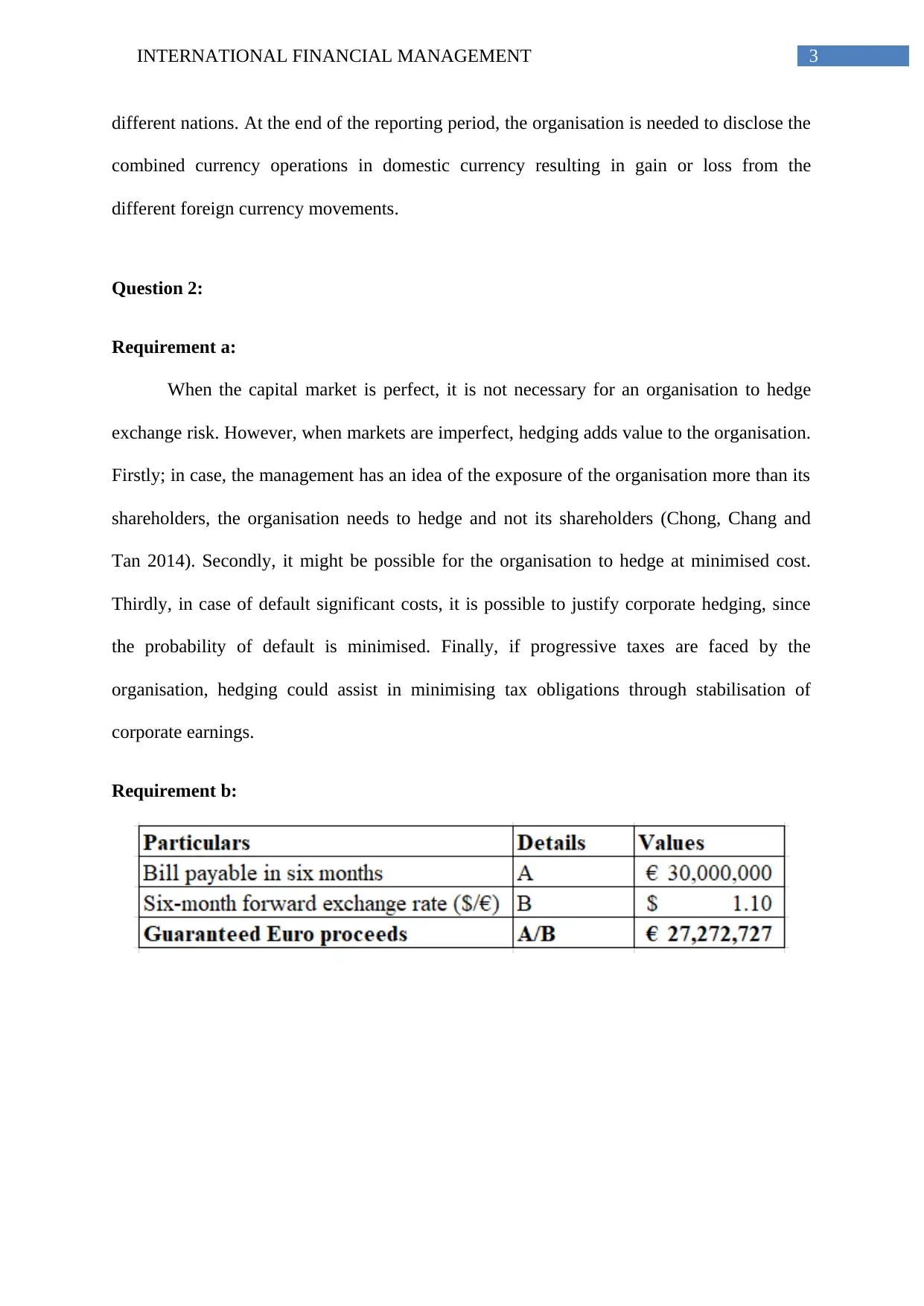
3INTERNATIONAL FINANCIAL MANAGEMENT
different nations. At the end of the reporting period, the organisation is needed to disclose the
combined currency operations in domestic currency resulting in gain or loss from the
different foreign currency movements.
Question 2:
Requirement a:
When the capital market is perfect, it is not necessary for an organisation to hedge
exchange risk. However, when markets are imperfect, hedging adds value to the organisation.
Firstly; in case, the management has an idea of the exposure of the organisation more than its
shareholders, the organisation needs to hedge and not its shareholders (Chong, Chang and
Tan 2014). Secondly, it might be possible for the organisation to hedge at minimised cost.
Thirdly, in case of default significant costs, it is possible to justify corporate hedging, since
the probability of default is minimised. Finally, if progressive taxes are faced by the
organisation, hedging could assist in minimising tax obligations through stabilisation of
corporate earnings.
Requirement b:
different nations. At the end of the reporting period, the organisation is needed to disclose the
combined currency operations in domestic currency resulting in gain or loss from the
different foreign currency movements.
Question 2:
Requirement a:
When the capital market is perfect, it is not necessary for an organisation to hedge
exchange risk. However, when markets are imperfect, hedging adds value to the organisation.
Firstly; in case, the management has an idea of the exposure of the organisation more than its
shareholders, the organisation needs to hedge and not its shareholders (Chong, Chang and
Tan 2014). Secondly, it might be possible for the organisation to hedge at minimised cost.
Thirdly, in case of default significant costs, it is possible to justify corporate hedging, since
the probability of default is minimised. Finally, if progressive taxes are faced by the
organisation, hedging could assist in minimising tax obligations through stabilisation of
corporate earnings.
Requirement b:
Paraphrase This Document
Need a fresh take? Get an instant paraphrase of this document with our AI Paraphraser
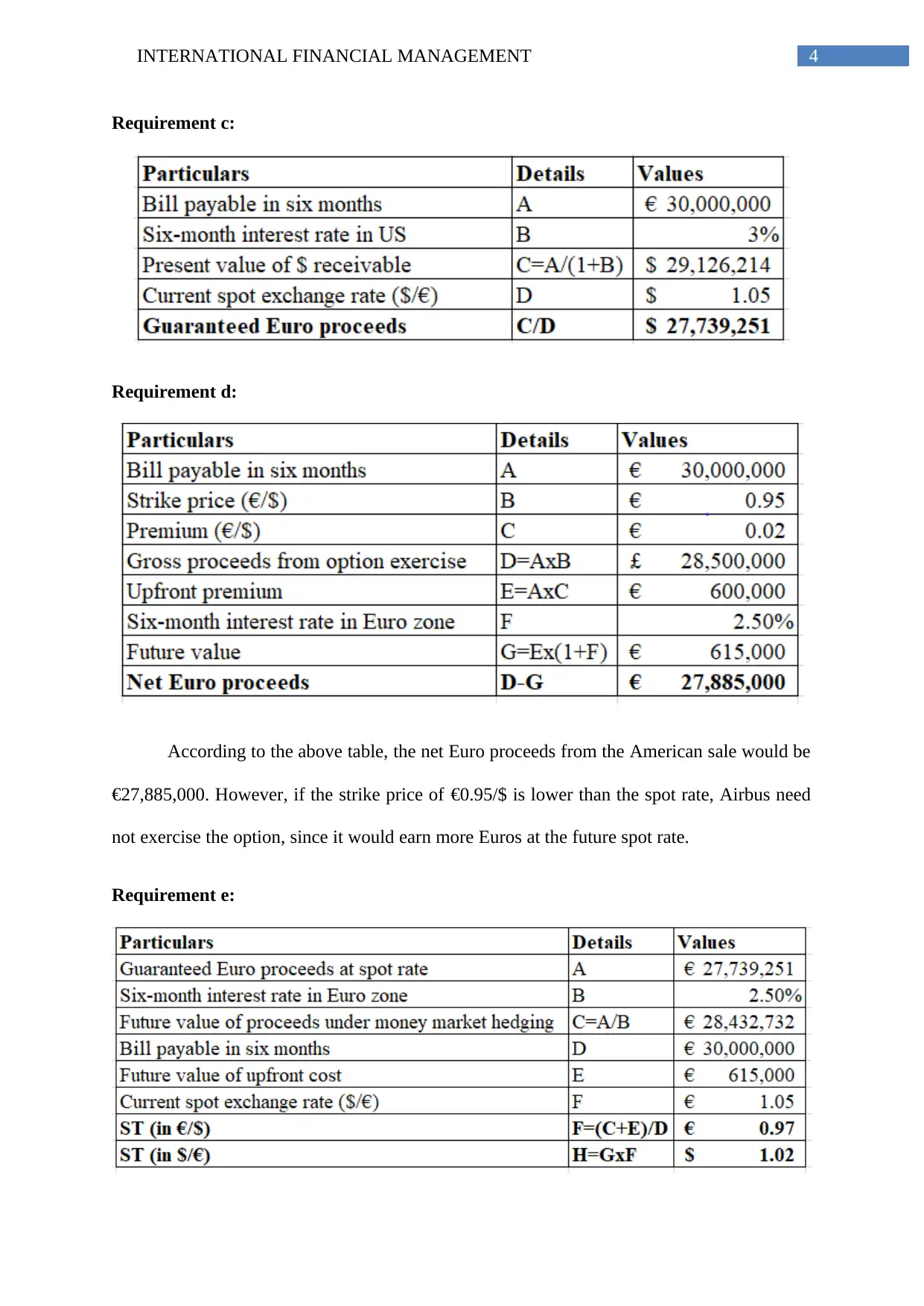
4INTERNATIONAL FINANCIAL MANAGEMENT
Requirement c:
Requirement d:
According to the above table, the net Euro proceeds from the American sale would be
€27,885,000. However, if the strike price of €0.95/$ is lower than the spot rate, Airbus need
not exercise the option, since it would earn more Euros at the future spot rate.
Requirement e:
Requirement c:
Requirement d:
According to the above table, the net Euro proceeds from the American sale would be
€27,885,000. However, if the strike price of €0.95/$ is lower than the spot rate, Airbus need
not exercise the option, since it would earn more Euros at the future spot rate.
Requirement e:
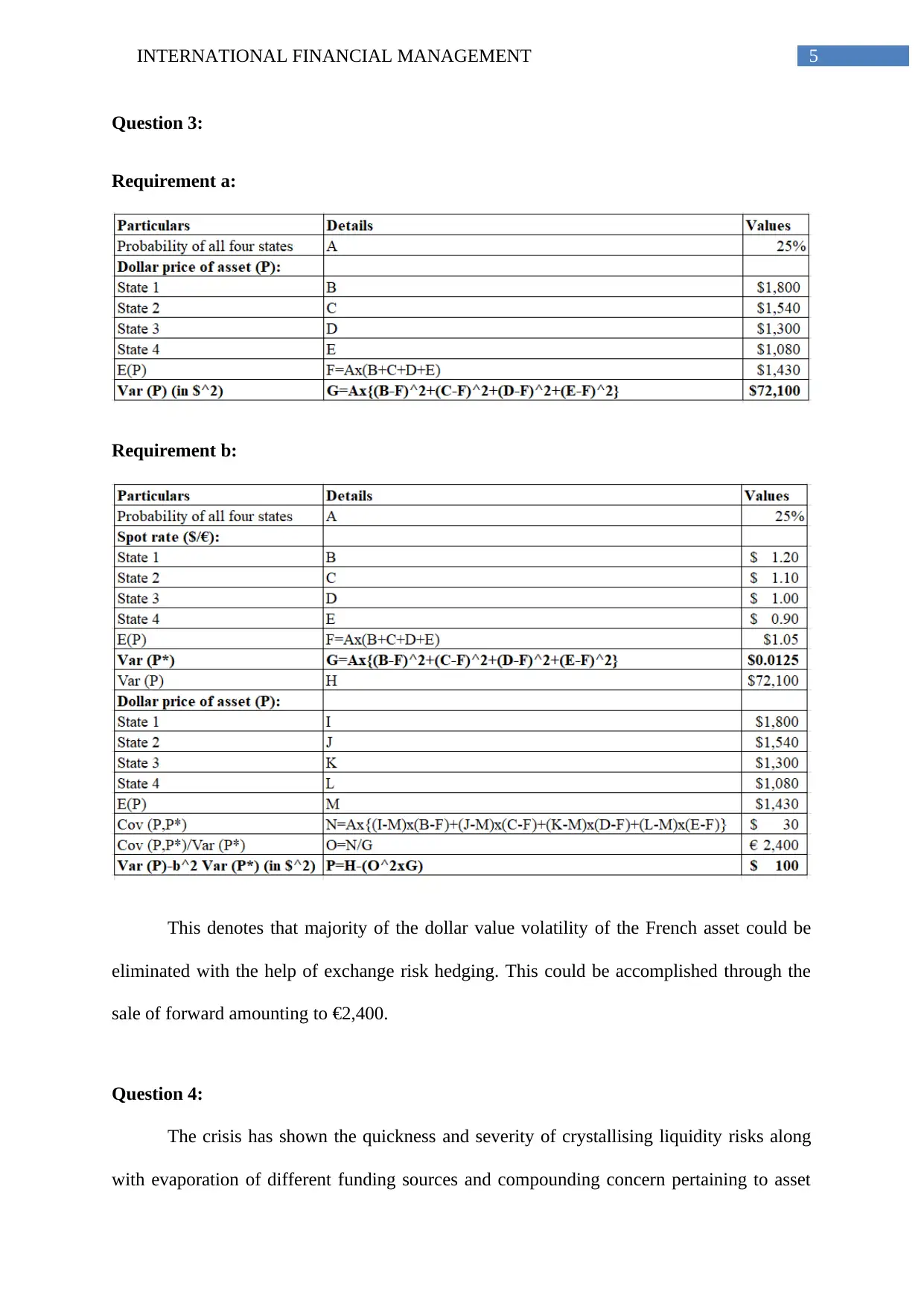
5INTERNATIONAL FINANCIAL MANAGEMENT
Question 3:
Requirement a:
Requirement b:
This denotes that majority of the dollar value volatility of the French asset could be
eliminated with the help of exchange risk hedging. This could be accomplished through the
sale of forward amounting to €2,400.
Question 4:
The crisis has shown the quickness and severity of crystallising liquidity risks along
with evaporation of different funding sources and compounding concern pertaining to asset
Question 3:
Requirement a:
Requirement b:
This denotes that majority of the dollar value volatility of the French asset could be
eliminated with the help of exchange risk hedging. This could be accomplished through the
sale of forward amounting to €2,400.
Question 4:
The crisis has shown the quickness and severity of crystallising liquidity risks along
with evaporation of different funding sources and compounding concern pertaining to asset
⊘ This is a preview!⊘
Do you want full access?
Subscribe today to unlock all pages.

Trusted by 1+ million students worldwide
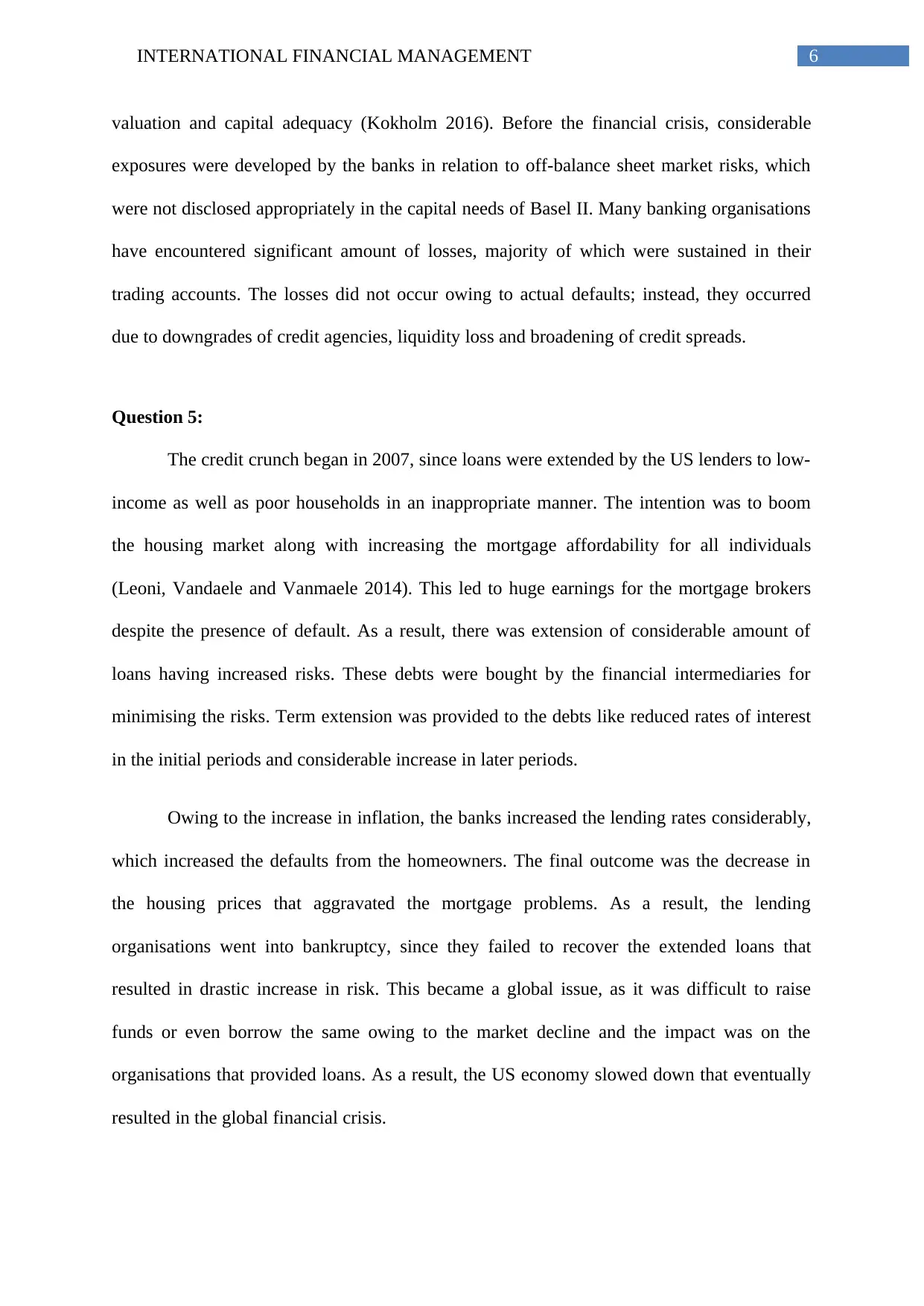
6INTERNATIONAL FINANCIAL MANAGEMENT
valuation and capital adequacy (Kokholm 2016). Before the financial crisis, considerable
exposures were developed by the banks in relation to off-balance sheet market risks, which
were not disclosed appropriately in the capital needs of Basel II. Many banking organisations
have encountered significant amount of losses, majority of which were sustained in their
trading accounts. The losses did not occur owing to actual defaults; instead, they occurred
due to downgrades of credit agencies, liquidity loss and broadening of credit spreads.
Question 5:
The credit crunch began in 2007, since loans were extended by the US lenders to low-
income as well as poor households in an inappropriate manner. The intention was to boom
the housing market along with increasing the mortgage affordability for all individuals
(Leoni, Vandaele and Vanmaele 2014). This led to huge earnings for the mortgage brokers
despite the presence of default. As a result, there was extension of considerable amount of
loans having increased risks. These debts were bought by the financial intermediaries for
minimising the risks. Term extension was provided to the debts like reduced rates of interest
in the initial periods and considerable increase in later periods.
Owing to the increase in inflation, the banks increased the lending rates considerably,
which increased the defaults from the homeowners. The final outcome was the decrease in
the housing prices that aggravated the mortgage problems. As a result, the lending
organisations went into bankruptcy, since they failed to recover the extended loans that
resulted in drastic increase in risk. This became a global issue, as it was difficult to raise
funds or even borrow the same owing to the market decline and the impact was on the
organisations that provided loans. As a result, the US economy slowed down that eventually
resulted in the global financial crisis.
valuation and capital adequacy (Kokholm 2016). Before the financial crisis, considerable
exposures were developed by the banks in relation to off-balance sheet market risks, which
were not disclosed appropriately in the capital needs of Basel II. Many banking organisations
have encountered significant amount of losses, majority of which were sustained in their
trading accounts. The losses did not occur owing to actual defaults; instead, they occurred
due to downgrades of credit agencies, liquidity loss and broadening of credit spreads.
Question 5:
The credit crunch began in 2007, since loans were extended by the US lenders to low-
income as well as poor households in an inappropriate manner. The intention was to boom
the housing market along with increasing the mortgage affordability for all individuals
(Leoni, Vandaele and Vanmaele 2014). This led to huge earnings for the mortgage brokers
despite the presence of default. As a result, there was extension of considerable amount of
loans having increased risks. These debts were bought by the financial intermediaries for
minimising the risks. Term extension was provided to the debts like reduced rates of interest
in the initial periods and considerable increase in later periods.
Owing to the increase in inflation, the banks increased the lending rates considerably,
which increased the defaults from the homeowners. The final outcome was the decrease in
the housing prices that aggravated the mortgage problems. As a result, the lending
organisations went into bankruptcy, since they failed to recover the extended loans that
resulted in drastic increase in risk. This became a global issue, as it was difficult to raise
funds or even borrow the same owing to the market decline and the impact was on the
organisations that provided loans. As a result, the US economy slowed down that eventually
resulted in the global financial crisis.
Paraphrase This Document
Need a fresh take? Get an instant paraphrase of this document with our AI Paraphraser
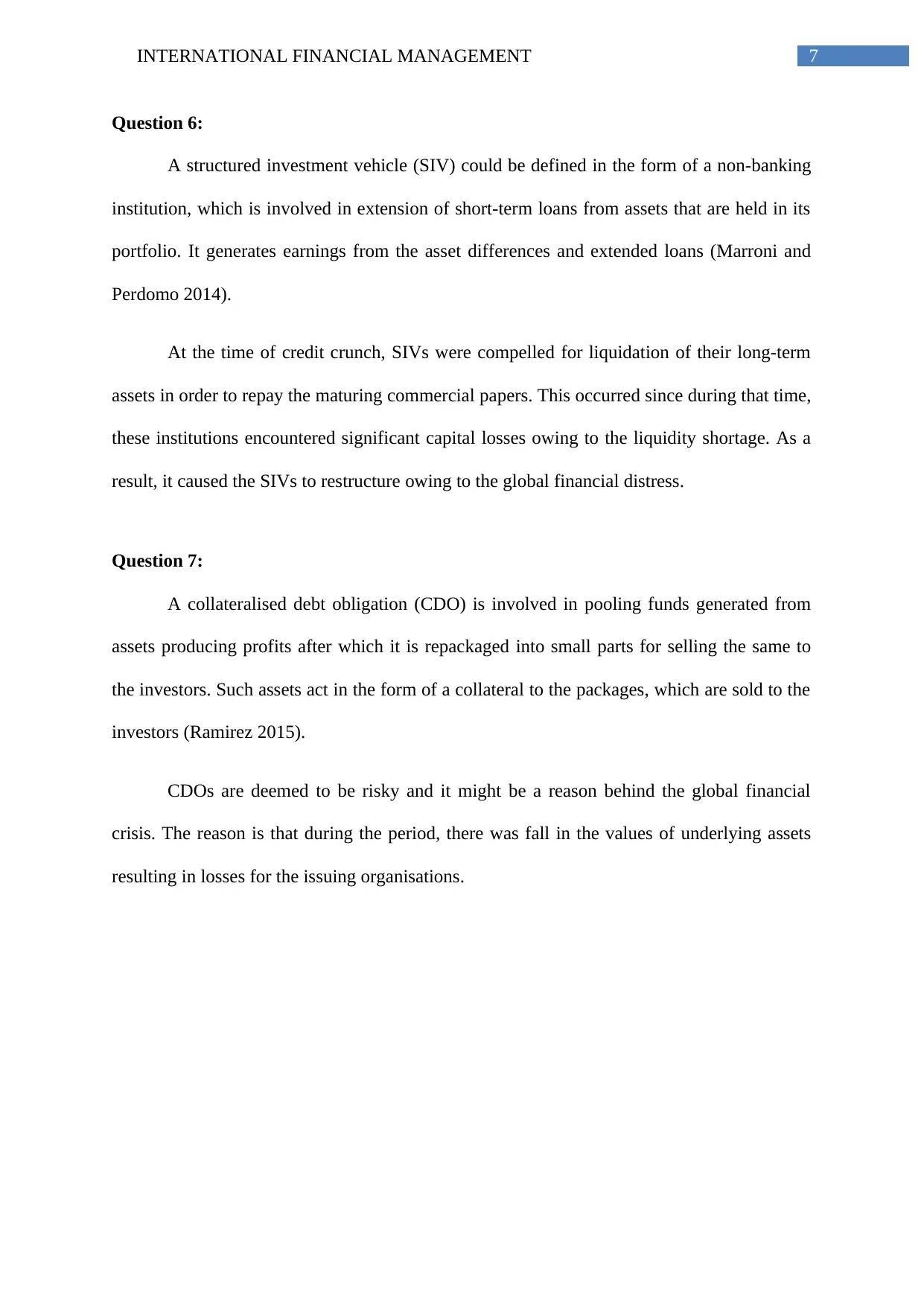
7INTERNATIONAL FINANCIAL MANAGEMENT
Question 6:
A structured investment vehicle (SIV) could be defined in the form of a non-banking
institution, which is involved in extension of short-term loans from assets that are held in its
portfolio. It generates earnings from the asset differences and extended loans (Marroni and
Perdomo 2014).
At the time of credit crunch, SIVs were compelled for liquidation of their long-term
assets in order to repay the maturing commercial papers. This occurred since during that time,
these institutions encountered significant capital losses owing to the liquidity shortage. As a
result, it caused the SIVs to restructure owing to the global financial distress.
Question 7:
A collateralised debt obligation (CDO) is involved in pooling funds generated from
assets producing profits after which it is repackaged into small parts for selling the same to
the investors. Such assets act in the form of a collateral to the packages, which are sold to the
investors (Ramirez 2015).
CDOs are deemed to be risky and it might be a reason behind the global financial
crisis. The reason is that during the period, there was fall in the values of underlying assets
resulting in losses for the issuing organisations.
Question 6:
A structured investment vehicle (SIV) could be defined in the form of a non-banking
institution, which is involved in extension of short-term loans from assets that are held in its
portfolio. It generates earnings from the asset differences and extended loans (Marroni and
Perdomo 2014).
At the time of credit crunch, SIVs were compelled for liquidation of their long-term
assets in order to repay the maturing commercial papers. This occurred since during that time,
these institutions encountered significant capital losses owing to the liquidity shortage. As a
result, it caused the SIVs to restructure owing to the global financial distress.
Question 7:
A collateralised debt obligation (CDO) is involved in pooling funds generated from
assets producing profits after which it is repackaged into small parts for selling the same to
the investors. Such assets act in the form of a collateral to the packages, which are sold to the
investors (Ramirez 2015).
CDOs are deemed to be risky and it might be a reason behind the global financial
crisis. The reason is that during the period, there was fall in the values of underlying assets
resulting in losses for the issuing organisations.
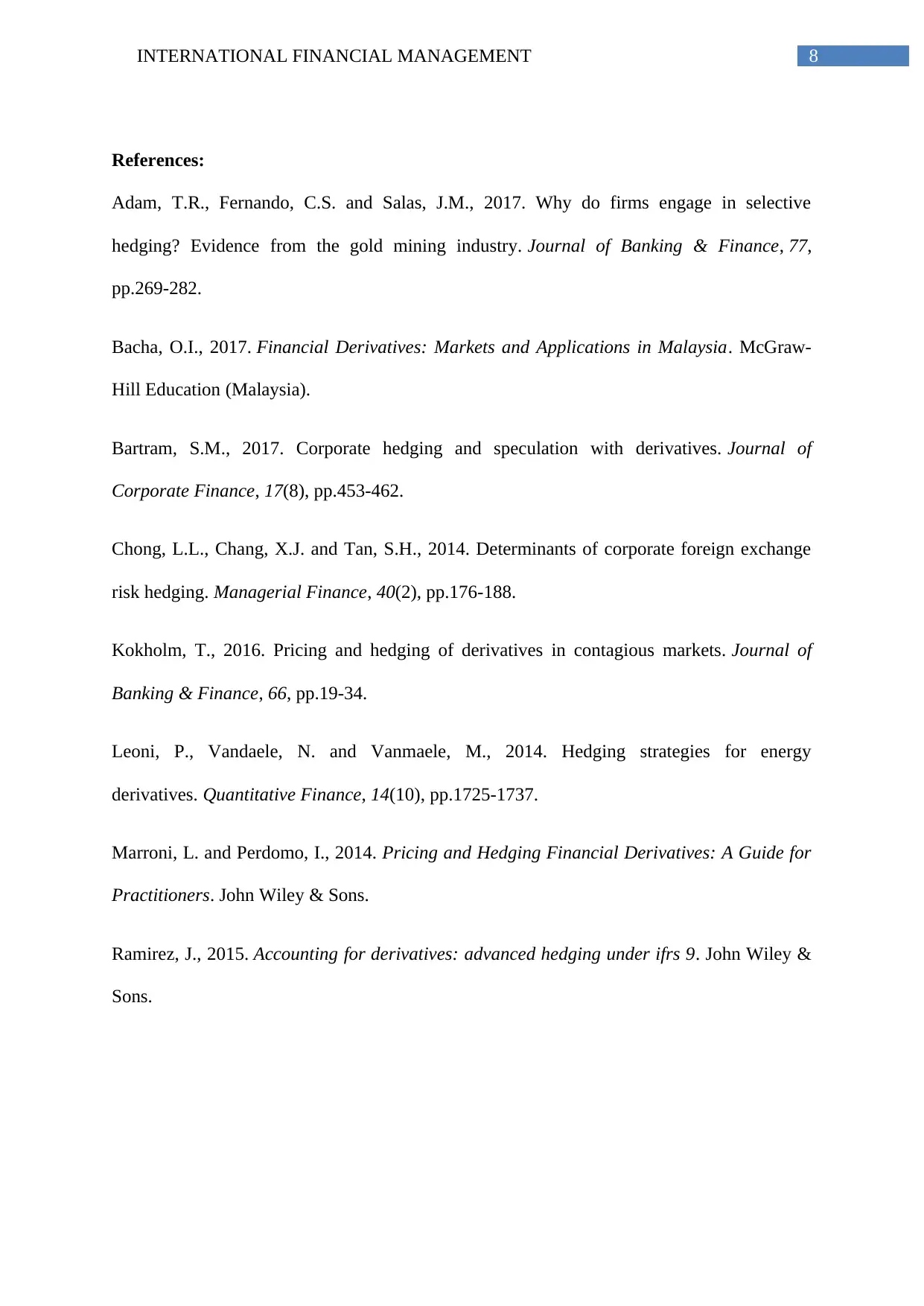
8INTERNATIONAL FINANCIAL MANAGEMENT
References:
Adam, T.R., Fernando, C.S. and Salas, J.M., 2017. Why do firms engage in selective
hedging? Evidence from the gold mining industry. Journal of Banking & Finance, 77,
pp.269-282.
Bacha, O.I., 2017. Financial Derivatives: Markets and Applications in Malaysia. McGraw-
Hill Education (Malaysia).
Bartram, S.M., 2017. Corporate hedging and speculation with derivatives. Journal of
Corporate Finance, 17(8), pp.453-462.
Chong, L.L., Chang, X.J. and Tan, S.H., 2014. Determinants of corporate foreign exchange
risk hedging. Managerial Finance, 40(2), pp.176-188.
Kokholm, T., 2016. Pricing and hedging of derivatives in contagious markets. Journal of
Banking & Finance, 66, pp.19-34.
Leoni, P., Vandaele, N. and Vanmaele, M., 2014. Hedging strategies for energy
derivatives. Quantitative Finance, 14(10), pp.1725-1737.
Marroni, L. and Perdomo, I., 2014. Pricing and Hedging Financial Derivatives: A Guide for
Practitioners. John Wiley & Sons.
Ramirez, J., 2015. Accounting for derivatives: advanced hedging under ifrs 9. John Wiley &
Sons.
References:
Adam, T.R., Fernando, C.S. and Salas, J.M., 2017. Why do firms engage in selective
hedging? Evidence from the gold mining industry. Journal of Banking & Finance, 77,
pp.269-282.
Bacha, O.I., 2017. Financial Derivatives: Markets and Applications in Malaysia. McGraw-
Hill Education (Malaysia).
Bartram, S.M., 2017. Corporate hedging and speculation with derivatives. Journal of
Corporate Finance, 17(8), pp.453-462.
Chong, L.L., Chang, X.J. and Tan, S.H., 2014. Determinants of corporate foreign exchange
risk hedging. Managerial Finance, 40(2), pp.176-188.
Kokholm, T., 2016. Pricing and hedging of derivatives in contagious markets. Journal of
Banking & Finance, 66, pp.19-34.
Leoni, P., Vandaele, N. and Vanmaele, M., 2014. Hedging strategies for energy
derivatives. Quantitative Finance, 14(10), pp.1725-1737.
Marroni, L. and Perdomo, I., 2014. Pricing and Hedging Financial Derivatives: A Guide for
Practitioners. John Wiley & Sons.
Ramirez, J., 2015. Accounting for derivatives: advanced hedging under ifrs 9. John Wiley &
Sons.
⊘ This is a preview!⊘
Do you want full access?
Subscribe today to unlock all pages.

Trusted by 1+ million students worldwide
1 out of 9
Related Documents
Your All-in-One AI-Powered Toolkit for Academic Success.
+13062052269
info@desklib.com
Available 24*7 on WhatsApp / Email
![[object Object]](/_next/static/media/star-bottom.7253800d.svg)
Unlock your academic potential
Copyright © 2020–2025 A2Z Services. All Rights Reserved. Developed and managed by ZUCOL.





